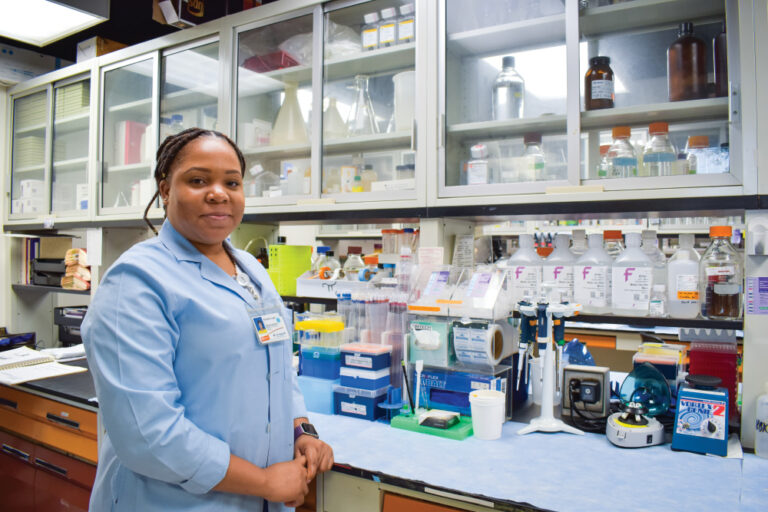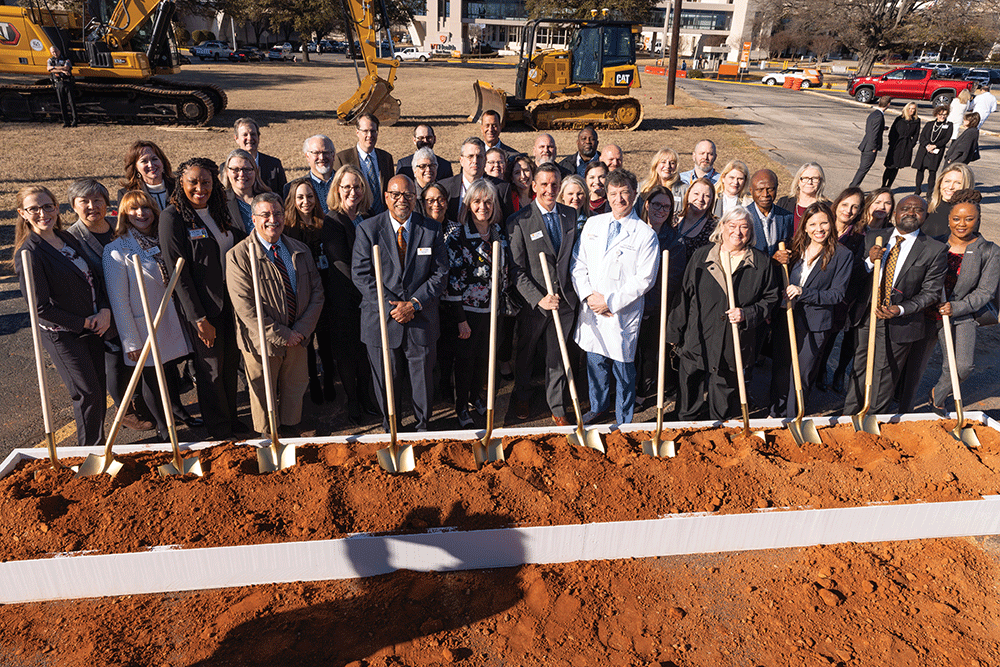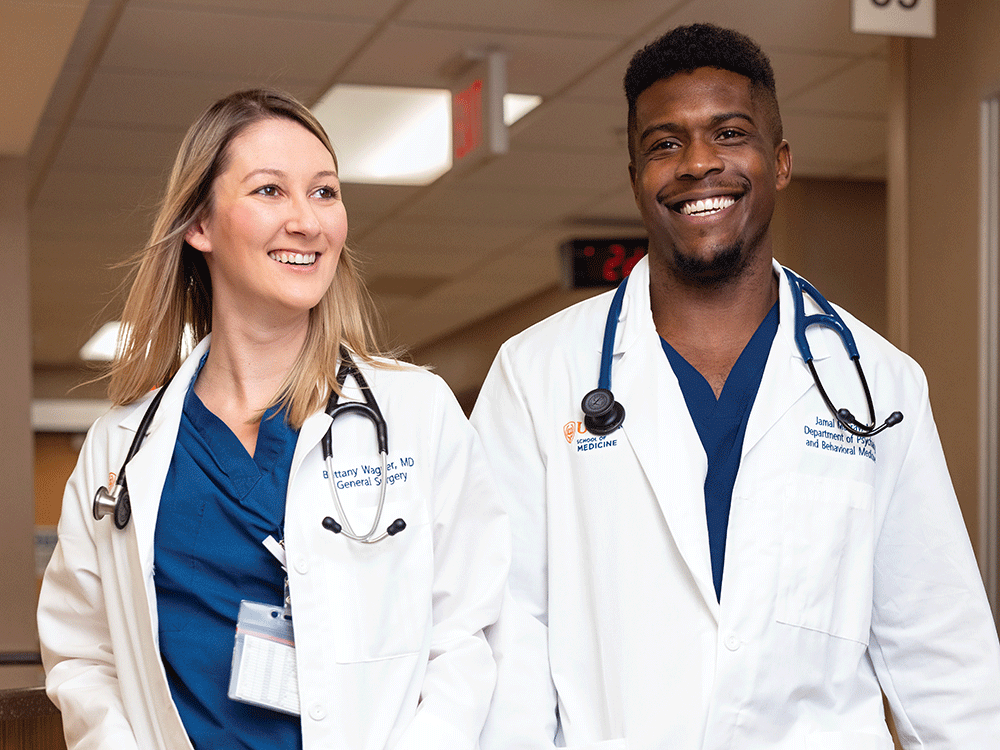New UT Tyler Medical School Boosts the Region’s Economy, Workforce and Quality of Life
A new University of Texas medical school is bringing jobs and high-quality health care to Tyler.

The first class of students to enter the new UT Tyler School of Medicine in July 2023 represents the culmination of a community’s dreams and will become part of the region’s health care future.
“I’ve never seen a community this excited about or supportive of a medical school,” says Dr. Brigham Willis, founding dean.
Willis moved from California to Tyler to lead the program and was drawn to the role because of the need for health care professionals in this historically underserved region.
“We are creating a community-embedded, mission-oriented medical school,” he says. “It’s really inspiring to be part of something with a meaningful mission, to get up every day and say we’re doing what we can to make a difference in people’s lives.”
In This Article
Home-Grown Talent
“We are focusing on active, hands-on, application-based learning to produce physicians who are from this area and who are committed to serving this area through primary, preventive, rural health care,” Willis says.
Full tuition and fees for the first two classes of medical students will be covered by generous philanthropic gifts. Willis says this helps with another part of the school’s mission, to keep the debt load for students low, making it more possible for them to go into primary preventive care in the region.
“Our admission process is focused on recruiting students from East Texas, the region they are going to serve,” Willis says. “There were a lot of students from East Texas who were applying to medical school and either going elsewhere or not getting in, so we saw a really strong talent pool that will be excited about serving the communities they grew up in.”
Connection to the region was one of the main criteria for narrowing the pool of nearly 4,000 applicants to the 40 who make up the inaugural class.
“It’s really cool to have students who grew up or have connections in the area coming back to medical school here,” Willis says. “We’re also trying to incorporate, to an equal extent, humanism, empathy, and personal characteristics, in addition to ensuring the applicants have great grades and test scores.”
The school is housed now in UT Tyler’s Health Science Center campus, until the new Medical Education Building opens in 2025. The planned five-story facility under construction in the heart of Tyler’s medical district in Midtown will include classrooms, simulation labs, and clinical and operating room training spaces for the medical school and residency programs. A planned skybridge will connect the building to UT Health East Texas Hospital, further supporting hands-on learning.

Future Focused
There are now nearly 20 medical residency and fellowship training programs, up from three just a few years ago.
“We’re putting together the facilities we need, and at the same time we’re trying to build out all the academic infrastructure that’s needed down the road,” Willis says. “Once students finish medical school, they have to be able to train in their communities. We’re promoting a model where we have graduate medical education programs in the rural communities, not just in the bigger cities.”
Just producing 40 physicians a year is not going to change the trajectory of health outcomes for the region, Willis says.
“We want to train people who are going to go to a small town and not just have their own small practice, but create health care systems to provide access to care, and work with teams of pharmacists, nurses and advanced practice providers to address the needs people have. That’s going to have an exponential effect on care.”

Changing the Trajectory
Economically, a study by The Perryman Group estimates that, when multiplier effects are considered, the new medical school will generate nearly $1.2 billion in annual gross product and 10,849 jobs in East Texas. For Texas as a whole, those projections reach $2.3 billion in annual gross product and 20,676 jobs.
Willis says the presence of a medical school has already impacted the broader talent pool.
“We’ve seen a flood of new applications from people who might not have considered coming to this particular area because there wasn’t a medical school. So that’s transformative, because these are incredible innovators and thinkers, and they are going to implement their own visions and build their own programs,” he says.
“Then that has ripple effects across the community – because of the medical school, you get all these talented faculty, you get expansion of programs, you get more research dollars, everything builds. It’s exciting on a lot of different levels.”

New Collaboration Supports Lifesaving Care
Another exciting development in health care in the region is a new collaboration between CHRISTUS Health and Texas Oncology. The Northeast Texas Cancer and Research Institute in Tyler is a specialized 85,000-square-foot facility where these two organizations work side by side to bring lifesaving treatments, as well as cancer prevention and cutting-edge research, to the patients they serve.
“CHRISTUS surgical oncologists and Texas Oncology medical and radiation oncologists now work together in the same facility,” says Dr. Steven Curley, institute chair for CHRISTUS Trinity Mother Frances Oncology Institute. “This facilitates real-time conversations about new or established patients requiring complex multidisciplinary decision-making and care.”
In the facility, Texas Oncology-Tyler has clinic space for several medical oncology services, including hematology, gynecologic and radiation oncology. There are 52 chemotherapy infusion stations, including six dedicated to research. Additionally, patients benefit from cancer prevention services, diagnostic screenings and a comprehensive genetic risk evaluation program, as well as access to Texas Oncology’s on-site pharmacy, lab and exercise area.
CHRISTUS Health has an advanced imaging center within the facility and another dedicated area to support the surgical oncology program of its Louise Herrington Cancer Center, which cares for complex cancer patients.
Curley says the facility offers cutting-edge technologies, including newest generation PET CT and dual-beam CT, which allow for much more rapid scan time and 3D rendering. “There’s also space in radiation oncology for the coming wave of targeted radio-pharmaceutical therapies,” he says.
In the research arena, Texas Oncology-Tyler previously has offered more than 550 clinical trials with thousands of patients and has helped develop immunotherapy drugs and other cancer treatments. Curly says numerous Phase 1, 2 and 3 trials are underway for all types of cancer, including circulating tumor DNA and circulating tumor cell trials, which can lead to earlier diagnoses of cancer or cancer recurrence.
Two separate organizations came together with one common goal, says Curley: to create a state-of-the-art multidisciplinary cancer center to serve residents of northeast Texas. The facility offers ample space and natural light that help create a healing environment.
“Patients live here because they don’t want to live in major urban areas,” Curley says. “They want world-class cancer care close to home that is timely, convenient and less expensive. Here, they don’t need to pay for parking and hotel rooms, and they can receive the support they need from their network of family and friends who live in their communities.”
Get to Know Tyler
Want to learn more about living and working in Tyler, TX? Check out the latest edition of Livability Tyler, TX.
